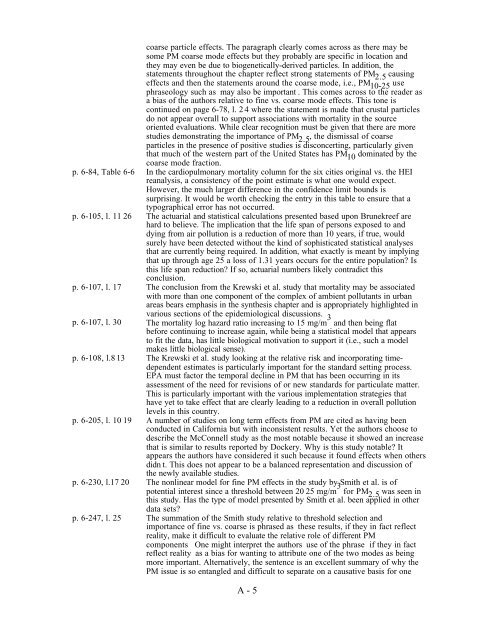Review of the Air Quality Criteria Document for Particulate Matter
Review of the Air Quality Criteria Document for Particulate Matter
Review of the Air Quality Criteria Document for Particulate Matter
- No tags were found...
Create successful ePaper yourself
Turn your PDF publications into a flip-book with our unique Google optimized e-Paper software.
coarse particle effects. The paragraph clearly comes across as <strong>the</strong>re may besome PM coarse mode effects but <strong>the</strong>y probably are specific in location and<strong>the</strong>y may even be due to biogenetically-derived particles. In addition, <strong>the</strong>statements throughout <strong>the</strong> chapter reflect strong statements <strong>of</strong> PM 2.5 causingeffects and <strong>the</strong>n <strong>the</strong> statements around <strong>the</strong> coarse mode, i.e., PM 10-25 usephraseology such as may also be important . This comes across to <strong>the</strong> reader asa bias <strong>of</strong> <strong>the</strong> authors relative to fine vs. coarse mode effects. This tone iscontinued on page 6-78, l. 2 4 where <strong>the</strong> statement is made that crustal particlesdo not appear overall to support associations with mortality in <strong>the</strong> sourceoriented evaluations. While clear recognition must be given that <strong>the</strong>re are morestudies demonstrating <strong>the</strong> importance <strong>of</strong> PM 2.5 , <strong>the</strong> dismissal <strong>of</strong> coarseparticles in <strong>the</strong> presence <strong>of</strong> positive studies is disconcerting, particularly giventhat much <strong>of</strong> <strong>the</strong> western part <strong>of</strong> <strong>the</strong> United States has PM 10 dominated by <strong>the</strong>coarse mode fraction.p. 6-84, Table 6-6 In <strong>the</strong> cardiopulmonary mortality column <strong>for</strong> <strong>the</strong> six cities original vs. <strong>the</strong> HEIreanalysis, a consistency <strong>of</strong> <strong>the</strong> point estimate is what one would expect.However, <strong>the</strong> much larger difference in <strong>the</strong> confidence limit bounds issurprising. It would be worth checking <strong>the</strong> entry in this table to ensure that atypographical error has not occurred.p. 6-105, l. 11 26 The actuarial and statistical calculations presented based upon Brunekreef arehard to believe. The implication that <strong>the</strong> life span <strong>of</strong> persons exposed to anddying from air pollution is a reduction <strong>of</strong> more than 10 years, if true, wouldsurely have been detected without <strong>the</strong> kind <strong>of</strong> sophisticated statistical analysesthat are currently being required. In addition, what exactly is meant by implyingthat up through age 25 a loss <strong>of</strong> 1.31 years occurs <strong>for</strong> <strong>the</strong> entire population? Isthis life span reduction? If so, actuarial numbers likely contradict thisconclusion.p. 6-107, l. 17 The conclusion from <strong>the</strong> Krewski et al. study that mortality may be associatedwith more than one component <strong>of</strong> <strong>the</strong> complex <strong>of</strong> ambient pollutants in urbanareas bears emphasis in <strong>the</strong> syn<strong>the</strong>sis chapter and is appropriately highlighted invarious sections <strong>of</strong> <strong>the</strong> epidemiological discussions.p. 6-107, l. 30 The mortality log hazard ratio increasing to 15 mg/m 3 and <strong>the</strong>n being flatbe<strong>for</strong>e continuing to increase again, while being a statistical model that appearsto fit <strong>the</strong> data, has little biological motivation to support it (i.e., such a modelmakes little biological sense).p. 6-108, l.8 13 The Krewski et al. study looking at <strong>the</strong> relative risk and incorporating timedependentestimates is particularly important <strong>for</strong> <strong>the</strong> standard setting process.EPA must factor <strong>the</strong> temporal decline in PM that has been occurring in itsassessment <strong>of</strong> <strong>the</strong> need <strong>for</strong> revisions <strong>of</strong> or new standards <strong>for</strong> particulate matter.This is particularly important with <strong>the</strong> various implementation strategies thathave yet to take effect that are clearly leading to a reduction in overall pollutionlevels in this country.p. 6-205, l. 10 19 A number <strong>of</strong> studies on long term effects from PM are cited as having beenconducted in Cali<strong>for</strong>nia but with inconsistent results. Yet <strong>the</strong> authors choose todescribe <strong>the</strong> McConnell study as <strong>the</strong> most notable because it showed an increasethat is similar to results reported by Dockery. Why is this study notable? Itappears <strong>the</strong> authors have considered it such because it found effects when o<strong>the</strong>rsdidn t. This does not appear to be a balanced representation and discussion <strong>of</strong><strong>the</strong> newly available studies.p. 6-230, l.17 20 The nonlinear model <strong>for</strong> fine PM effects in <strong>the</strong> study by Smith et al. is <strong>of</strong>potential interest since a threshold between 20 25 mg/m 3 <strong>for</strong> PM 2.5 was seen inthis study. Has <strong>the</strong> type <strong>of</strong> model presented by Smith et al. been applied in o<strong>the</strong>rdata sets?p. 6-247, l. 25 The summation <strong>of</strong> <strong>the</strong> Smith study relative to threshold selection andimportance <strong>of</strong> fine vs. coarse is phrased as <strong>the</strong>se results, if <strong>the</strong>y in fact reflectreality, make it difficult to evaluate <strong>the</strong> relative role <strong>of</strong> different PMcomponents One might interpret <strong>the</strong> authors use <strong>of</strong> <strong>the</strong> phrase if <strong>the</strong>y in factreflect reality as a bias <strong>for</strong> wanting to attribute one <strong>of</strong> <strong>the</strong> two modes as beingmore important. Alternatively, <strong>the</strong> sentence is an excellent summary <strong>of</strong> why <strong>the</strong>PM issue is so entangled and difficult to separate on a causative basis <strong>for</strong> oneA - 5
















